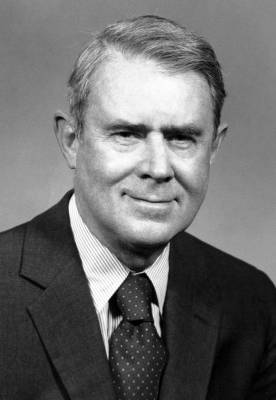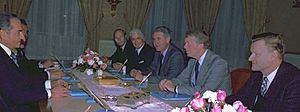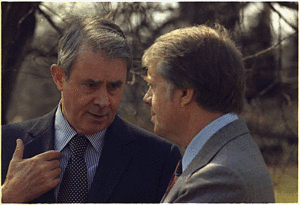Cyrus Vance facts for kids
Quick facts for kids
Cyrus Vance
|
|
|---|---|
 |
|
| 57th United States Secretary of State | |
| In office January 20, 1977 – April 28, 1980 |
|
| President | Jimmy Carter |
| Deputy | Warren Christopher |
| Preceded by | Henry Kissinger |
| Succeeded by | Edmund Muskie |
| 11th United States Deputy Secretary of Defense | |
| In office January 28, 1964 – June 30, 1967 |
|
| President | Lyndon B. Johnson |
| Preceded by | Roswell Gilpatric |
| Succeeded by | Paul Nitze |
| 7th United States Secretary of the Army | |
| In office July 5, 1962 – January 21, 1964 |
|
| President | John F. Kennedy Lyndon B. Johnson |
| Preceded by | Elvis Jacob Stahr Jr. |
| Succeeded by | Stephen Ailes |
| General Counsel of the Department of Defense | |
| In office January 29, 1961 – June 30, 1962 |
|
| President | John F. Kennedy |
| Preceded by | Vincent Burke |
| Succeeded by | John McNaughton |
| Personal details | |
| Born |
Cyrus Roberts Vance
March 27, 1917 Clarksburg, West Virginia, U.S. |
| Died | January 12, 2002 (aged 84) New York City, U.S. |
| Resting place | Arlington National Cemetery |
| Political party | Democratic |
| Spouse |
Gay Sloane
(m. 1947) |
| Children | 5, including Cyrus Jr. |
| Relatives | John W. Davis (adoptive father) |
| Education | Yale University (BA, LLB) |
| Signature |  |
| Military service | |
| Branch/service | United States Navy |
| Years of service | 1942–1946 |
| Rank | Lieutenant |
| Unit | USS Hale (DD-642) |
| Battles/wars | World War II |
Cyrus Roberts Vance Sr. (March 27, 1917 – January 12, 2002) was an American lawyer and important government official. He served as the United States Secretary of State under President Jimmy Carter from 1977 to 1980. The Secretary of State is like the country's top diplomat, handling foreign relations.
Before this, Vance was the United States Deputy Secretary of Defense during President Lyndon B. Johnson's time. He also worked as the United States Secretary of the Army and a top lawyer for the Department of Defense under President John F. Kennedy.
As Secretary of State, Vance believed in solving problems through talks and agreements, not fighting. He was very interested in reducing the number of weapons countries had. He resigned from his job in April 1980 because he disagreed with a secret military mission to rescue American hostages in Iran.
Cyrus Vance was the father of Cyrus Vance Jr., who became a district attorney in New York.
Contents
Early Life and Family Background
Cyrus Vance was born on March 27, 1917, in Clarksburg, West Virginia. His parents were John Carl Vance II and Amy Roberts Vance. He had an older brother named John Carl Vance III. When Cyrus was young, his family moved to Bronxville, New York. This allowed his father, who was an insurance broker, to work in New York City. Sadly, his father died suddenly in 1922 when Cyrus was only five years old.
After her husband's death, Vance's mother took her sons to Switzerland for a year. There, Cyrus and his brother learned to speak French. Vance's older cousin, John W. Davis, became a very important person in his life. Davis was a well-known lawyer and had been an ambassador. He became Cyrus's mentor and later adopted him.
Vance finished high school at Kent School in 1935. He then went to Yale University, where he earned his first degree in 1939. While at Yale, he played ice hockey and was part of a secret society. He continued his studies at Yale Law School and graduated in 1942. Many of his classmates later became important government officials themselves.
Military Service in World War II
During World War II, Cyrus Vance joined the United States Navy. He served as a gunnery officer on a destroyer ship called the USS Hale (DD-642). He was involved in several major battles at sea until 1946. These battles included the Battle of Tarawa and the Philippines Campaign (1944–1945).
After the war, Vance worked for a year at a company called Mead Corporation. Then, he joined a law firm in New York City called Simpson Thacher & Bartlett.
In 1947, when he was 29, Vance married Grace Elsie "Gay" Sloane. She was a college graduate whose father was a business leader. Cyrus and Gay had five children together.
Key Roles in Government Service
In 1957, a senator named Lyndon B. Johnson asked Vance to work for the United States Senate Committee on Armed Services. Vance helped create the law that led to the creation of NASA, which is the U.S. space agency.
In 1961, Vance became the top lawyer for the Department of Defense. Soon after, President John F. Kennedy made him the United States Secretary of the Army. As Secretary of the Army, Vance helped send soldiers to Mississippi in 1962. Their job was to protect James Meredith and make sure the University of Mississippi allowed its first African American student to enroll.
In 1964, Vance became the United States Deputy Secretary of Defense. President Johnson sent him to handle important situations. He went to the Panama Canal Zone after student protests. He also went to Detroit after riots there. Later, he helped deal with a hostage situation in South Korea involving the USS Pueblo ship.
Vance initially supported the Vietnam War, but by the late 1960s, he changed his mind. He resigned from his position and advised the president to withdraw from South Vietnam. He later called the failed peace talks about Vietnam "one of the great tragedies in history." In January 1969, he received the Presidential Medal of Freedom, a very high honor.
In 1970, Vance was appointed to a special group called the Knapp Commission. This group investigated corruption within the New York City Police Department. The commission held public hearings and helped lead to changes and better oversight of the police.
From 1974 to 1976, Vance was the president of the New York City Bar Association. After his time as Secretary of State, he returned to his law practice. However, he was often called back to public service for diplomatic missions. He worked on peace efforts in places like Bosnia, Croatia, and South Africa. He also helped solve a disagreement over the Nagorno-Karabakh region.
Secretary of State: Diplomacy and Challenges

President Jimmy Carter chose Cyrus Vance to be his United States Secretary of State. Vance played a key role in many important international agreements. He helped negotiate the Torrijos–Carter Treaties about the Panama Canal. He also worked on peace talks in Rhodesia, Namibia, and South Africa.
Vance worked closely with Israeli leaders to achieve the Camp David Accords in 1978. This was a historic peace agreement between Israel and Egypt.
Vance believed in building stronger ties with the Soviet Union. He often disagreed with the President's National Security Advisor, Zbigniew Brzezinski, who favored a tougher approach. Vance focused on the SALT II agreement with the Soviet Union. This agreement aimed to limit the number of nuclear weapons each country had. Brzezinski, however, pushed for a stronger stance against the Soviets. He also successfully pushed for the U.S. to have normal relations with People's Republic of China in 1978.
As Brzezinski became more involved in negotiations, Vance's influence decreased. When a revolution started in Iran in late 1978, Vance and Brzezinski had different ideas on how to support the Shah of Iran, who was an ally of the U.S. Vance wanted reforms, while Brzezinski wanted a stronger response. The mixed messages the Shah received may have added to his confusion. He fled Iran in January 1979, and his government collapsed.
Vance directly negotiated the SALT II agreement with the Soviet ambassador. In June 1979, President Carter and Soviet leader Leonid Brezhnev signed the treaty. However, the U.S. Senate did not approve it.
After the Soviet invasion of Afghanistan in December 1979, Vance's views on working with the Soviets became less popular. He tried to secretly negotiate a solution to the Iran hostage crisis through another group, but it did not work. Vance believed diplomacy could bring the hostages home safely. He initially opposed Brzezinski's idea of a military rescue.
While Vance was away, the National Security Council approved a secret military mission called Operation Eagle Claw. This mission aimed to rescue the American hostages in Tehran. Vance was not informed about this decision.
On April 21, Vance resigned in protest, calling Brzezinski "evil." He was one of only a few Secretaries of State to resign because of a disagreement over policy. The rescue operation was later stopped after some helicopters had problems. A helicopter also crashed into a transport plane, killing eight servicemen. Vance's resignation was confirmed, and he was replaced by Edmund Muskie. The hostages were eventually released through diplomatic efforts after 444 days.
Later Career and Legacy
In 1991, Cyrus Vance was appointed as a Special Envoy for the Secretary-General of the United Nations. He proposed a plan to help solve the conflict in Croatia. Both Croatia and Serbia agreed to his plan, but some local leaders did not accept it. He continued to work on peace plans for the region.
In January 1993, as a UN Special Envoy, Vance worked with Lord David Owen on a peace plan to end the Bosnian War. This plan was also rejected, and Vance resigned from this role.
Vance was a member of important organizations like the American Academy of Arts and Sciences. In 1993, he received the Sylvanus Thayer Award from the United States Military Academy at West Point. In 1995, he again served as a Special Envoy for the UN. He helped witness an agreement between North Macedonia and Greece regarding a naming dispute.
Vance also served on the boards of major companies like IBM and The New York Times. He was a trustee at Yale Corporation and chairman of the Rockefeller Foundation.
Cyrus Vance passed away on January 12, 2002, at the age of 84. He was buried at Arlington National Cemetery. His wife, Gay, passed away in 2008.
Vance received several awards for his public service. These include the Presidential Medal of Freedom in 1969 and the Freedom Medal in 1993. In 1999, he received the Lifetime Contributions to American Diplomacy Award. His mother's house, the Stealey-Goff-Vance House, is now home to the Harrison County Historical Society.
Images for kids
See also
 In Spanish: Cyrus Vance para niños
In Spanish: Cyrus Vance para niños



